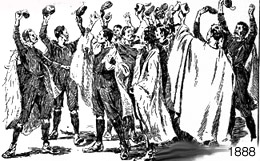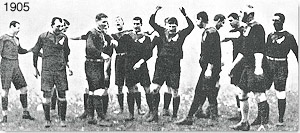Home - Kiwi Songs - Maori Songs - Search - Donate
- 1884
- A New Zealand team in New South Wales used a Maori war cry to introduce
itself to its opponents before each of its matches.
A Sydney newspaper reported: "The sound given in good time and union by 18 pairs of powerful lungs was sometimes tremendous. The NSW men declared it was hardly fair of the visitors to frighten them out of their wits before the game began."
- 1888
- A New Zealand "Native" team performed an Ake Ake Kia Kaha,
For ever! And ever! be strong! haka before
the first match of their tour of Britain. The team had to pay its own
way and the pre match haka, using native mats and other traditional
costume, was a money-making drawcard.
- 1897
- The New Zealand rugby team to Australia performed the Tuhoe version of Ka Mate as their "tiger" before each match.
- 1903
- the New Zealand team to Australia (the first to play an official test
match) used a "greeting and warcry" written for them by haka
expert Mr Charles Parata MP.
Tena koe, Kangaroo
Tupoto koe, Kangaroo!
Niu Tireni tenei haere nei
Au Au Aue a!How do you do, Kangaroo!
You look out, Kangaroo!
New Zealand is invading you
Woe woe woe to you!
-
 1905
- "The Originals," the 1905 All Black team in Britain popularised the Ngati Kahungunu version of the
Ka Mate haka there. They performed
it before the famous Welsh test, "The war cry
went well," wrote the Lyttelton Times, "And
the crowd listened and watched in pleased silence, and thundered their
approval at its close.
1905
- "The Originals," the 1905 All Black team in Britain popularised the Ngati Kahungunu version of the
Ka Mate haka there. They performed
it before the famous Welsh test, "The war cry
went well," wrote the Lyttelton Times, "And
the crowd listened and watched in pleased silence, and thundered their
approval at its close.
"Then the Welsh team started their national anthem. Forty thousand Welsh voices caught up the noble strain, and from every comer of the ground rose the deep, swelling, heart-stirring chorus 'Mae hen wlad fy nhadau' The land of my Fathers.
- 1913 -
the All Black tour of America. "The team was
given a big welcome on arrival in San Francisco and before disembarking
they gave their haka, which had the crowd yelling their approval."
- 1914 -
By the time of the First World War, the Ka Mate haka was established
as part of top New Zealand rugby.
- 1924
- The "Invincibles" touring team in Britain had their own haka, Ko
Niu Tireni written
for them during their sea voyage by Judge Acheson of the the Native
Land Court and Wiremu Rangi of Gisborne. Lardelli's Kapa
o Pango is derived from this haka.

Kia whakangawari au i a hau.
I au-e! Hei!
Ko Niu Tireni e haruru nei.
Ka tu te ihiihi.
Ka tu te wanawana
... MORE
Get ready for the clash.
Yeah! Ha!
New Zealand is rumbling here.
Face up to the fear
Fight the terror
- 1926
- the New Zealand Maori team further popularised the Ka Mate haka during
their tour of France, England, Wales and Canada.
- 1928
- the All Black team touring South Africa did not include any Maori
players, but nevertheless the Ka Mate haka was performed before seven
matches, including three of the tests "and as usual was well received."
- 1987
- With the advent of televised rugby, the haka began to be performed
regularly in home games too, under the leadership of Buck Shelford (red
arrow).

"Buck was the greatest haka-leader of them all," said Zinzan Brooke. "He meant every word of it and he made every word and gesture stick." (Previously the haka had been performed in NZ only against South Africa for the 3rd test in 1921, and at all tests against Scotland in 1975.)

- 1991 -
the New Zealand Women's team were asked for a haka at the World Cup,
and responded with part of the men's haka. Realising this was not really
appropriate, the 1994 team obtained permission from the Ngati Porou
to use their women's haka, Ka Panapana. Here they perform it
at the 1998 World Cup.
A ra ra! Ka panapana, A ha ha
Ka rekareka tonu taku ngakau
Ki nga mana ririki i pohatu whakapiri
Kia haramai te takitini,
Kia haramai te takimano,
Kia paretaitokotia ki Rawhiti! Hi! Ha!
He mamae, he mamae! A ha ha!
Ka haere, ka haere taku powhiri
Ki te Tai Whakarunga!
Hoki mai, hoki mai taku tinana!....
Kia huri au ki te tai whakatu a Kupe
Ki te tai o Matawhero i motu mai!
E ko te hoariri ki roto i aku ringa,
Kutia rawatia kia pari tona ihu!
Hi ha! Aue ana! Kss! Kss hei!
Kia whakanga hoki au i ahau. I aue! Hei!Lo, it is throbbing! A ha ha!
Constantly delighting my heart
with the small forces knocking together
May there be multitudes of them bursting in
thousands of them irrupting.
May they flow to the Eastern Sea. Hi! Ha!
A yearning, an ache! A ha ha!
My invitation goes out
To the Southern Sea!
Come back, come back to my body!...
I turn to the sea which Kupe raised up
To the sea which breaks at Gisborne!
The assailant in my grasp is digging away,
He'll be squeezed, choked, until his nose is flowing
Hi! Ha! Kss! Kss!
Now let me pause and rest awhile. Oh! Ahhh!
- 2005 - the All Blacks performed Kapa O Pango for the first time, using phrases taken from the ancient haka Ruaumoko, and from the 1924 All Blacks' haka Ko Niu Tirini. This haka compares their driving energy to the elemental forces that continue to shape New Zealand. Full haka
- 2007
- the NZ Maori team have been performing Timatanga.
I te timatanga
Ko te kore
Ko te po nui
Ko te po roa
...Full haka here .In the beginning
there was nothing
a big darkness
a long darkness.
...
And of course just about every New Zealand high school 1st XV do their own unique haka before any important inter-college rugby match these days.
A video of the history of haka in New Zealand
NEXT - 5. The 1924 All Black haka. Home - Kiwi Songs - Maori Songs - Search - Donate
Ka
Mate webpage written
by John Archer.
Nov 1999. Revised Jan 2002.
Lost, and reinstalled 13 March 2003. Revised 2006, 2007, 2008
Content divided into eight smaller pages Sept 2008